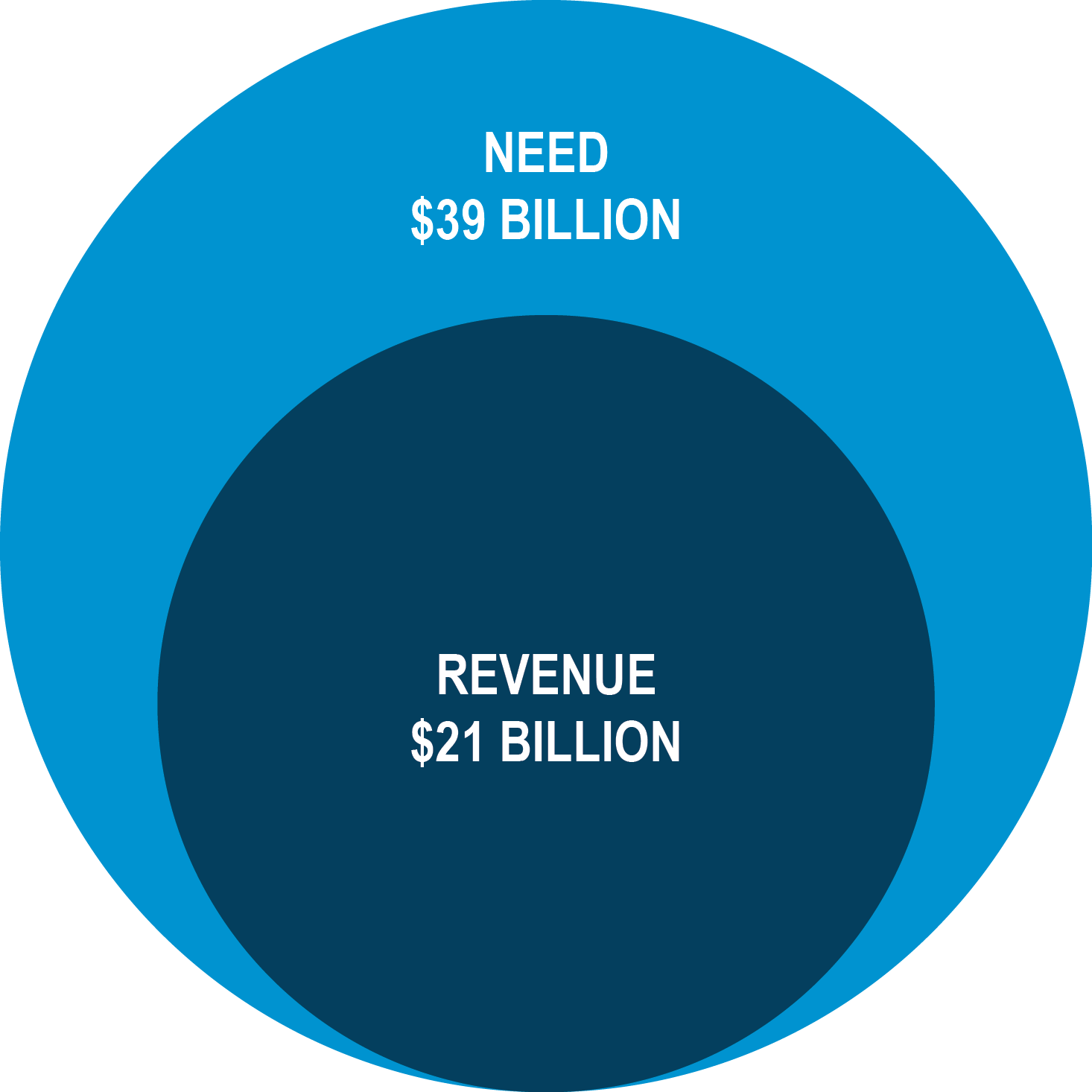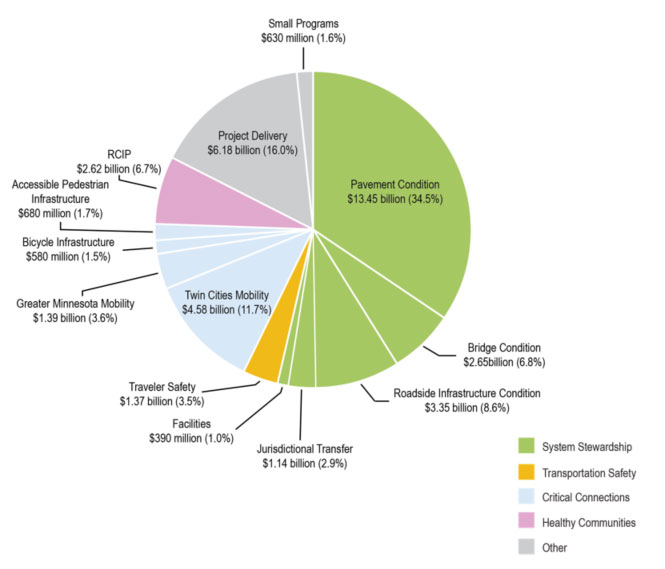Executive Summary
The Purpose of MnSHIP
- Chapter 2 - Revenue Forecast
- Chapter 2 - Federal Law
- Chapter 2 - State Requirements
- Chapter 2 - MnDOT Policy
- Chapter 2 - Current System Conditions and Long-Term Trends
- Appendix F (coming soon)
- Appendix G
The 20-Year Minnesota State Highway Investment Plan (MnSHIP) directs capital investment for Minnesota’s state highway system. The plan must identify investment priorities given current and expected funding. It is updated every four years, as required by the Minnesota Statute. This MnSHIP update spans the 20-year planning period from 2018 to 2037.
The Minnesota Department of Transportation takes into account many factors in developing MnSHIP. The plan prioritizes future investments to address the widening gap between highway revenues and construction costs. MnSHIP also considers federal and state laws, MnDOT policy and current and expected future conditions on the state highway system. These factors are described in more detail in Chapter 2, Key Factors and Assumptions.
MnSHIP describes how MnDOT will use capital investments to repair, replace and improve the state highway system. The plan does not address how MnDOT funds the operation of the system or day-to-day maintenance.
Relationship To MnDOT’s Plans And Programs
MnSHIP is part of a “family of plans” that connects vision and policy direction for transportation in Minnesota to how MnDOT selects projects and makes improvements on the state highway system. The Statewide Multimodal Transportation Plan describes statewide objectives and strategies that help MnDOT and its partners make progress toward the Minnesota GO 50-Year Vision. MnSHIP links policies and objectives in the Minnesota GO 50-Year Vision and the Statewide Multimodal Transportation Plan with capital investments on the state highway system.
Investment Category Descriptions
- Chapter 2 - Current System Conditions and Long-Term Trends
- Chapter 3 - Summary of Needs
- Chapter 5 - Investment Summary
- Chapter 6 - Unmet Needs
- Appendix I
MnDOT invests in the state highway system through various types of capital improvement projects. Some projects enhance the condition of existing infrastructure, while others add new infrastructure to the system. MnDOT tracks capital investment in highways by investment categories. Investment categories are components of projects. A single MnDOT project can include investment from multiple different investment categories. The 2013 version of MnSHIP identified 10 investment categories. This MnSHIP update includes four additional investment categories. The individual categories are separated into five major investment objective areas as illustrated in Figure ES-1.
Figure ES-1: MnSHIP Investment Categories and Objective Areas
| System Stewardship | Transportation Safety | Critical Connections | Healthy Communities | Other |
|---|---|---|---|---|
|
|
|
|
|
20-Year Revenue Projection
During the next 20 years, MnDOT estimates that $21 billion in revenue will be available for capital investment on the state highway system – approximately $1 billion per year. This estimate assumes that no new major sources of revenue will be introduced and that the majority of MnDOT’s future revenues will originate from four main revenue sources (federal aid, state gas tax, tab-fees and motor vehicle sales tax).
MnDOT anticipates that the actual amount of funding it receives from the State Trunk Highway Fund will increase by approximately 2 percent per year over the next 20 years. However, two key trends will make it increasingly difficult for MnDOT to sustain current conditions on the state highway system:
- Construction costs are growing more quickly than revenues: Expected revenues will lose buying power as construction costs continue to grow at an annual rate of 4.5 percent.
- Revenue growth continues to be slow: Vehicles are becoming more fuel efficient and vehicle miles travelled has remained flat over the last decade.
Summary of Needs
- Chapter 1 - Investment Category Descriptions
- Chapter 2 - Current System Conditions and Long-Term Trends
- Chapter 5 - Investment Summary
- Chapter 6 - Unmet Needs
- Appendix I
In developing its assumptions for MnSHIP, MnDOT projected the investments necessary to meet state highway transportation needs through 2037. This need was determined by the costs required to meet performance-based targets and other key system goals, such as advancing the state’s economic vitality and supporting Minnesotans’ quality of life. The total need for the Minnesota state highway system is calculated to be approximately $39 billion over 20 years. MnDOT estimates it will have $21 billion to invest in the state highway system over the same time period, resulting in an $18 billion funding gap. Figure ES-3 shows the distribution of the $39 billion need by investment category. This level of investment would ensure that the state highway system meets all federal and state performance requirements and makes substantial progress toward realizing the Minnesota Go Vision. It would also allow MnDOT to effectively manage its greatest risks in each investment category.
Figure ES-2: Comparison of Investment Need and Available Revenue

Figure ES-3: Transportation Needs During the Next 20 Years (by Investment Category)

Investment Summary
- Chapter 1 - Investment Category Descriptions
- Chapter 2 - Current System Conditions and Long-Term Trends
- Chapter 3 - Summary of Needs
- Chapter 4 - Setting of 20-Year Investment Direction
- Chapter 5 - Investment Summary
- Chapter 6 - Unmet Needs
- Chapter 6 - Increased Revenue Priorities
- Appendix I
The 20-year investment direction established in MnSHIP focuses on maintaining the existing state highway system while making limited mobility investments. This approach reflects both MnDOT and stakeholder input and meets key requirements and agency commitments. It also continues a shift for MnDOT from being a builder of the system to the maintainer and operator of the system. The investment direction does not impact the projects already developed and programmed in Years 2018 through 2021. The priorities identified in this plan will be reflected in investments and projects starting in 2022. Figure ES-4 shows the distribution of expenditures through all years of the plan. Information on the investment direction in MnSHIP can be found in Chapter 5, Investment Direction.
Figure ES-4: 20-Year Capital Highway Investment Direction

Biggest Strengths
The investment direction makes progress toward goals in all four investment objective areas. MnDOT’s priorities reflect the public’s input that calls for a diversified approach, as well as one that prioritizes maintenance of the transportation system. Outcomes for each investment area include:
- System Stewardship: MnDOT focuses a majority of investment on maintaining the condition of roads, bridges, and roadside infrastructure. Federal targets for pavement and bridge condition are likely to be met.
- Transportation Safety: MnDOT will continue to focus on lower cost, proactive treatments aimed at preventing fatalities and serious injuries.
- Critical Connections: MnDOT commits to achieving substantial compliance with the Americans with Disabilities Act no later than 2037. MnDOT also commits to planned mobility investments in the Twin Cities metro area through 2023.
- Healthy Communities: Through the Transportation and Economic Development program, investments will be made to address local concerns through partnerships, design add-ons and a few stand- alone projects to support economic competitiveness and quality of life.
Biggest Drawbacks
The investment approach offers a limited response to increasing infrastructure and multimodal needs. Several challenges remain, including:
- System Stewardship: Conditions of roads, bridges and roadside infrastructure decline on NHS and non-NHS routes.
- Transportation Safety: Only a limited number of locations with a sustained crash history will be addressed.
- Critical Connections: The number and scope of mobility improvements decreases substantially, potentially reducing the ability to maintain reliable travel times in the Twin Cities area and Greater Minnesota. Resources are not available to address growing areas of the state.
- Healthy Communities: The investment direction limits MnDOT’s ability to address local concerns.
Plan Outcomes
MnDOT will make progress in all investment areas, but not all performance targets will be met (Figure ES-5). Pavement and bridge conditions are expected to worsen between 2018 and 2037. Travel time reliability in the Twin Cities is expected to decline due to projected regional growth.
Figure ES-5: Total Investments, Outcomes and Current Condition
| Investment Category | Objective Area | Current Conditions (2015) | Projected Outcome(s) in 2037 | Total Investment (2018-2037) |
|---|---|---|---|---|
| Pavement Condition | System Stewardship | Meet MnDOT targets and GASB 34 thresholds for NHS and Non-NHS pavement condition. • Interstate: 2.1% poor • NHS: 2.7% poor • Non-NHS: 5.1% poor | NHS and Non-NHS pavement condition worsen. Interstate condition worsens but meets federal target. Maintain GASB 34 threshold on the NHS. • Interstate: 4.0% poor • NHS: 8.0% poor • Non-NHS: 18.0% poor | $10.31 billion |
| Bridge Condition | System Stewardship | Meet GASB 34 thresholds for both NHS and Non-NHS for bridge condition. Only Non-NHS meets MnDOT targets for bridge condition. • NHS: 3.0% poor • Non-NHS: 3.1% poor | Non-NHS bridge conditions worsen, while NHS bridge condition is maintained. GASB 34 thresholds are met but NHS thresholds are not. • NHS: 5.0% poor • Non-NHS: 7.0-8.0% poor | $2.38 billion |
| Roadside Infrastructure Condition | System Stewardship | Roadside infrastructure condition is not meeting targets. • Culverts: 13.0% poor • Deep Storm Water Tunnels: 24.0% poor • Overhead Sign Structures: 30.0% poor | The condition of all roadside infrastructure assets will be maintained. Condition targets for culverts, deep storm water tunnels, and overhead sign structures will not be met. • Culverts: 14.0-15.0% poor • Deep Storm Water Tunnels: 23.0-24.0% poor • Overhead Sign Structures: 25.0% poor | $1.60 billion |
| Jurisdictional Transfer | System Stewardship | 2,653 miles of misaligned roads. Transfer of misaligned roads continues. | MnDOT will transfer over 900 miles of roadway between the state and local agencies. | $90 million |
| Facilities | System Stewardship | 6.0% of rest areas in good condition and nearly half in poor condition. Repair or replacement of weigh scales is not keeping pace with need. | 6.0% of rest areas will remain in good condition. Weigh scale and weigh station replacement will not keep pace resulting in outdated or inoperable sites. | $80 million |
| Traveler Safety | Transportation Safety | Safety improvements are made proactively with low cost/high benefit projects. Total fatalities and serious injuries have plateaued after decade-long decline. | Safety improvements made at a reduced rate. There is limited ability to address locations with high sustained crash rates. Total fatalities and serious injures may see an increase. | $670 million |
| Twin Cities Mobility | Critical Connections | Congestion remains relatively flat. MnPASS express lanes and spot mobility improvements are completed where needed. | Travel time reliability likely to decrease. Investments made in two MnPASS corridors and six spot mobility improvements between 2018 and 2023. | $240 million |
| Greater Minnesota Mobility | Critical Connections | A few corridors of mostly urban highways have decreased reliability during peak travel times. | Corridors likely to see decreased travel time reliability. 6-10 operational and low-cost capital improvements are completed. | $25 million |
| Freight | Critical Connections | - | - | $610 million |
| Bicycle Infrastructure | Critical Connections | The condition of the state bicycle network is maintained and new bicycle improvements are being made where needed. | Reduced investment in new improvements and maintenance of existing bicycle infrastructure leads to deterioration of bicycle network. | $140 million |
| Accessible Pedestrian Infrastructure | Critical Connections | Progress is being made towards ADA-compliant pedestrian infrastructure. Non-ADA pedestrian improvements are limited. • Sidewalks not ADA compliant: 54.0% | Infrastructure on the pedestrian network will be substantially compliant with standards. Some non-ADA projects will increase pedestrian access. | $530 million |
| Regional and Community Improvement Priorities | Healthy Communities | Economic development and quality-of-life improvements are being made through partnerships and project upgrades. | MnDOT will respond to 2-5 economic development opportunities per year through the TED program. | $310 million |
| Project Delivery | Other | Invest the amount necessary to deliver projects in the other categories. | Invest the amount necessary to deliver projects in the other categories. | $3.27 billion |
| Small Programs | Other | - | Continue to invest in small programs such as off-system bridges and historic properties. | $630 million |
| TOTAL | $21.0 billion |
Relationship of MnSHIP Investment Direction to Project Selection
MnSHIP is not a project-specific plan. The investment direction established in MnSHIP is by investment category. MnDOT’s districts select projects that follow the MnSHIP investment direction and help make progress toward MnDOT goals and objectives. These projects are presented in the 10-Year Capital Highway Investment Plan. The first four years of the CHIP make up the State Transportation Improvement Program. Projects in the STIP are well-defined and typically considered a commitment. The projects identified in the final six years of the CHIP are not commitments; they are anticipated to change as project development progresses and needs are better understood. The CHIP is updated annually to address new project-level information as well as infrastructure conditions and system performance. MnDOT districts are responsible for designing, delivering and constructing selected projects.
Projects are implemented annually through the STIP which documents the projects that MnDOT will fund and deliver over the upcoming four years. Annual updates of the STIP allow MnDOT to make timely changes that incorporate new investment decisions based on new plan strategies, investment priorities or system performance. Further information on project selection can be found in Chapter 5, Investment Direction and Appendix E: Financial Summary.
Priorities For Additional Funding
During the second round of the public outreach process, MnDOT asked stakeholders what their priorities would be should MnDOT receive any additional funding. The public was asked to prioritize which categories they would like to see MnDOT invest in, beyond what is being invested through the proposed investment direction. MnDOT senior leadership and key staff were also asked their preference for investing additional revenue. Figure ES-6 on the following page shows the ranking of stakeholder and MnDOT priorities for additional funding. Stakeholders and the public generally agreed that any extra funding MnDOT receives for capital improvements on the state highway network should be spent maintaining and repairing MnDOT’s existing assets. For the public, poorly maintained pavements and bridges were seen as a safety issue. Both groups believed investment in capacity or mobility improvements are priorities but disagreed on the preferred investment category. There was also agreement that main street improvements are important.
Based on input from the public and transportation stakeholders and MnDOT’s own internal priorities, MnDOT would prioritize spending additional funding on:
- Maintaining and repairing existing assets on the state highway system
- Strategically improving mobility and reliability at high priority locations on the National Highway System
- Reconstructing Main Streets
Figure ES-6: Priorities for Additional Funding

Such activities would allow MnDOT to limit the number of bridges and miles of pavement in poor condition, bringing the highway system closer to Interstate and NHS performance targets. Additional funding would increase MnDOT’s ability to address deteriorating culverts, signage and other supporting infrastructure. MnDOT would also be able to address more urban reconstruction, or Main Street projects. These projects allow local governments to improve amenities and facilities along the state highway. Mobility improvements in the Twin Cities area would be consistent with the Met Council’s Transportation Policy Plan, such as constructing MnPASS lanes and follow the strategies for Twin Cities Mobility listed in MnSHIP. Mobility improvements in Greater Minnesota would focus on the locations with the greatest performance issues and focus on low-cost/high benefit improvements. Completing these additional priority projects would allow MnDOT to cost-effectively meet long term performance targets and further advance the Minnesota GO Vision for transportation.
